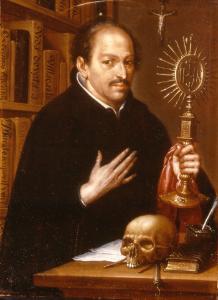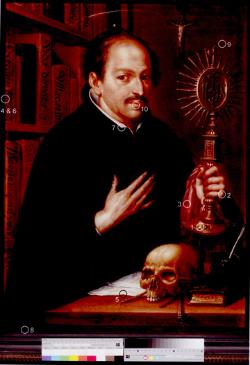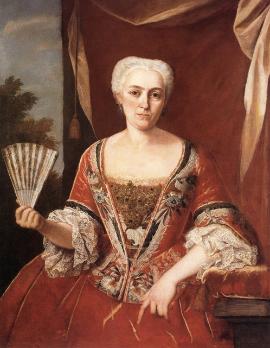Masterpiece under the Microscope

Portrait of a Jesuit Saint: San Francisco de Borja, 1726
Introduction
Increasingly, science is proving to be a valuable tool for art historians as they seek to learn more about the history of a work of art. This painting, signed by the eighteenth-century Spanish artist Bernardo Lorente Germán (1680–1759), has long been something of an enigma. Little is known about the artist outside of Spain. When acquired for the Martin D’Arcy Collection, the painting was thought to depict Saint Ignatius of Loyola, the founder of the Jesuit Order. But that identification sat uneasily with the Jesuits of Loyola University Chicago. The image simply did not look like the saint, whose visage was well known among artists from a death mask and through the dissemination of prints.
In 2008, I decided to undertake a two-pronged scholarly analysis of the painting. A review of the historical evidence was presented earlier this year in the installation entitled A Portrait in Search of an Identity. In summary, I determined that this painting, the artist’s earliest dated work, is not of St. Ignatius of Loyola (1491–1556) but rather of San Francisco de Borja (1510–1572), the Order’s third Superior General. The skull, a highly unusual attribute for St. Ignatius, symbolizes San Francisco’s renunciation of his Spanish dukedom to become a Jesuit priest.
Presented below are the findings of a scientific analysis of the painting itself. Conducted by Joseph Barabe, Senior Research Microscopist at McCrone Associates in Westmont, Illinois, and Maura Checconi, a trained conservator, these findings cannot answer the question of the saint’s identity, but they provide considerable information about the technique and intentions of the artist.
Visual Physical Review
The first step was to conduct a visual review of the physical object. Once removed from its frame, the painting measures 86.2 cm tall by 62.8 cm wide. It was executed on a linen canvas, bare patches of which are evident along edges usually hidden by the frame. The frame, though it suits the painting well, is not original. Relatively recently, the painting was attached to a new stretcher or wooden frame. While the original nail holes can still be seen, the canvas is now secured by modern staples. The outline of the stretcher can be seen if you view the painting under a raking light. It appears as four creases running 3.2 cm within the edges of the canvas. The wooden bars of the stretcher and the modern staples are visible in the radiograph displayed on the next panel. A fine craquelure (network of cracks in the paint layer) pervades the surface of the painting, developed over time as the layers of paint dried and contracted slightly. An even craquelure is a good indication that a painting is old. Here, there is a discernible change in the craquelure’s pattern around the jewel in the base of the monstrance held in the saint’s hand, indicating an area of minor damage and later overpainting.

Canvas edge showing original nail holes and modern staples.
 Canvas edge showing original nail holes and modern staples.
Canvas edge showing original nail holes and modern staples.
Imaging
The human eye responds to a relatively narrow band of the electromagnetic spectrum. Science can augment an art historian’s vision, making visible the layers beneath the surface of a painting, thus revealing information about the artist’s technique and original intent.
Infrared Reflectography
By using a digital camera sensitive to infrared light, we can see beneath the surface layer of paint. Frequently, underdrawings are revealed, especially those executed with a carbon-based pigment, such as pencil or ink. If in the surface layer the artist changed his composition by painting over an earlier element, the original composition in a lower paint layer would be revealed in an infrared photograph.
As neither underdrawing nor compositional alterations were detected, it appears Lorente Germán had fully prepared his composition, perhaps in sketches, before he began to paint. He worked directly on the canvas without the use of a preparatory sketch and without noticeably changing his intention as the painting progressed.
The signature titles of the bound books and the artist’s inscription show up particularly clearly. This finding indicates that both are genuine, authenticating both the identity of the figure as a Jesuit saint (the books are Jesuit texts) and the work itself.


Berndo Luis Lorente Germán faciebat a° 1726
Bernardo Luis Lorente Germán made this in the year 1726
(Signature digitally enhanced)
Ultraviolet Photography
When viewed under ultraviolet light, overpainting (layers added to the original surface) become visible, usually indicating a restoration. Like wrinkles on humans, small areas of paint loss come with age, so one expects to find in a few touch-ups on an Old Master.
This painting is in very good condition. What we see is largely what the artist, rather than a later restorer, painted—certainly in the most important areas such as the saint’s face and the objects on the table. However, it is clear that the canvas was torn and repaired in two places: a slash across the skull’s right eye socket and a right-angled tear leading from the skull to the base of the monstrance in the saint’s left hand.

Ultraviolet fluorescence photograph
X-Radiography
Paintings can be X-rayed just like humans. The denser the material, whether bone or for a painting a pigment made with lead, the whiter it appears on an X-ray. The work was X-rayed in sections the size of a standard X-ray plate. The single image presented here is a mosaic of those radiographs.
In this predominantly dark and somber painting, the areas in which the artist employed white lead to highlight such features as the saint’s face and hands, the skull and paper on the table, and the monstrance appear very light. Also visible is the wooden stretcher to which the painting has been stapled.
 |
 |
Pigment Sampling
Samples of the painting’s principal pigments were taken using a fine-point tungsten needle (see below). Sampling locations are marked on the accompanying photograph. Each sample was only as large as the width of a human hair. Each was subjected to energy dispersive X-ray spectrometry (EDS) and infrared spectroscopy (IR).
Energy Dispersive X-Ray Spectrometry
EDS is useful in determining which atomic elements are present in a sample. Using a microscope that bombards the sample with electrons (a scanning electron microscope), energy is reflected in the form of X-rays. The energies are then recorded on a visual graph. Because each element has different characteristic energies, the elements can be determined through the peaks on the graph. Based on the elements present and their ratios to one another (in addition to historical knowledge and the visual color of the sample), specific pigments are deduced.
Infrared Spectroscopy
IR is useful in deciphering non-mineral pigments—in this instance, cochineal and indigo. Infrared light is shined through a sample, and the amount of light that passes through (the percent transmittance) is recorded on a graph. Each material has specific absorption patterns. By comparing the graphs of the samples to graphs of known samples, the specific pigment is determined.

Pigment Sampling
Click on the links for details on each sample.
| Sample 1 | Sample 2 | Sample 3 |
| Sample 4 & 6 | Sample 5 | Sample 7 |
| Sample 8 | Sample 9 | Sample 10 |
Cross Sectioning
Using a microscalpel, a cross section was cut through the various paint layers at a point on the left edge of the canvas (marked as Sample 6 on the previous panel). The color of each layer is recorded in the photomicrograph below. In the SEM image at 500x magnification the brightness of the particles is dependent upon the atomic weights of their elements. The particles composed of heavier elements, such as lead, appear brighter than the particles of lighter elements, like carbon or calcium.
By comparing the layers in the photomicrograph and the elements in the SEM image, we can identify the components of each layer. In the former, we see that layers 1 through 4 are predominantly composed of chalk and clay with varying amounts of iron earth.

Layer 1 is light, transparent, and reddish brown. This layer is in contact with the painting’s linen canvas.
Layer 2 is semitransparent and colorless.
Layer 3 is a richer and more reddish brown than Layer 1.
Layer 4 is a light brown layer of paint.
Layer 5 corresponds to Sample 4 in the previous Pigment Sampling panel. Taken from the “P” in the title of a shelved book, it is predominantly carbonaceous. The pigment lampblack is made from carbon (soot).

In the SEM, there are numerous lead white particles, the agglomeration of which has caused the bright white area seen slightly left of center. To the right of this cluster are a number of star-like particles of calcium carbonate crystals (CaCO3), most likely formed with the paint layer. Occasional silica particles are scattered throughout the image.
Comparative Analysis
Earlier in the year, we learned there are two related paintings to the D’Arcy’s Portrait of a Saint in private Spanish collections. One portrays Saint Francis Xavier, another Jesuit saint. It was originally the pendant to the D’Arcy painting, for the two are of equal size and balance each other compositionally. They also have similar signatures and are dated 1726.
The other painting of interest is a copy of the D’Arcy painting. There are a number of differences between the two. The Madrid version is noticeably smaller, particularly in its width, measuring 81.8 x 51.7 cm. Presumably, the need to adapt the composition to a narrower canvas explains why the Madrid copy lacks a crucifix in the background and has different books on the shelves behind the saint. Additionally the signature (Berndo Luis Lorente faciebat) takes a slightly different form and is not dated.
|
Portrait of a Jesuit Saint: San Francisco de Borja, 1726 |
 |
The copy itself underwent scientific analysis some years ago. Maura Checconi and Joseph Barabe took care to match their sampling of the D’Arcy painting with that undertaken by Icono I&R on the Madrid copy. Slightly different analytical techniques were employed, but some conclusions may still be drawn. A comparative table is provided here. Both paintings were executed in a similar fashion using two different ground layers: the lower layer a reddish color, the upper one brown. Among the similar pigments used were lead white, lead tin yellow, lampblack, and cochineal. The Madrid copy was not tested for indigo, used by the artist to create shadow on the saint’s white collar. Nor was vermilion detected, though it appears in trace amounts in all of the red areas in the D’Arcy painting. Indeed, it seems that on the original, Lorente Germán tended to mix colors, which was not done in the copy. A number of colors, such as indigo, yellow ochre, and umber, were mixed into the lampblack used for the saint’s cassock (see Pigment Analysis, Sample 6), whereas in the Madrid version there is only the suggestion of bitumen (a tar-like form of petroleum) added. The dark lettering on the books’ spines (Sample 4) in the D’Arcy’s painting comprises lampblack, cochineal, lead white, chalk, and vermilion. Conservator Maura Checconi is of the opinion that mixing leftover colors from the palette was not an unusual practice for some artists. That they do not appear in the Madrid version may simply be due to the fact that Lorente Germán did not have leftover colors to mix into the lampblack. As the Madrid painting is not dated, it may have been painted at a different time. It is also possible that the copy was mostly the work of an assistant who did not use leftover colors.
 |
 |
Icono I&R also sampled a portrait of Doña Mauela Petronila de Urtusaustegui executed by the artist in 1735. A noteworthy change in the color of this painting’s ground was identified. Over an initial reddish-brown layer, the artist had lain a light grey layer mixed with coarsely ground lead white. This effect had an influence on the hue of the colors used to depict his sitter: the colors appear brighter, and the painting’s overall tonality is less somber than those of the Jesuit saints.

Doña Manuela Petronila de Urtusaustegui, 1735
Fernando Quiles García and Ignacio Cano Rivero, Bernardo Lorente Germán y la
Pintura Sevillana de su Tiempo (1680-1759), Simois Getion de Arte, S.L, 2006.
Conclusion
The pigment analysis of Bernardo Lorente Germán’s earliest dated works tells us as much about his training and the artistic milieu of Seville at the outset of his career as it does specifically about him and his youthful talent. Seville had long been Spain’s leading educational and religious center. It had been the preferred work place of two of Spain’s greatest Baroque artists, Francisco de Zurbarán and Bartolomé Esteban Murillo. Indeed, Lorente Germán was initially trained in a style imitative of the latter. His somber palette and preference for a reddish-brown ground tied him closely to the earlier masters and the city’s established artistic traditions.
The recipes for the majority of his pigments were centuries old; however, it is interesting to note his use of cochineal. The port of Seville benefitted from a monopoly over imports from Spain’s colonies. Thus, this New World pigment was in abundant supply. It seems a safe assumption that the indigo found here also came from the Americas.
Three years after this painting was executed, the Spanish Court moved to Seville for five years. The accession of the French-born Philip V to the throne revolutionized Spanish art and as the realm’s temporary capital, Seville was suddenly exposed to a new aesthetic. Philip V espoused the lighter and more colorful French Rococo style over the somber Baroque of the previous Hapsburg dynasty. The change detected in the preparation of the ground in Lorente Germán’s portrait of Doña Manuela Petronila de Urtusaustegui reflects his exposure to the new style.
Invited to follow the court back to Madrid, Lorente Germán elected to remain in Seville.
As an artist, he was content to work with the established conventions of his native city.
Acknowledgements
I am grateful to Jean Westrick for her initial invitation for LUMA to participate in Science Chicago, and to Science Chicago itself for its generous funding of both the analytical research and the exhibition.
Chicago is fortunate to have a leading center for microscopal analysis in McCrone Research Associates, Inc., which provided numerous in-kind services for this project. It was a very great pleasure to work with and learn from Senior Research Microscopist Joseph Barabe, who made this exhibition possible.
I must thank Angela Karlovich and William Wallin, X-ray technicians at Elmhurst Memorial Hospital for the care and skill with which they X-rayed the painting.
This exhibition is but one D’Arcy project on which Maura Checconi has volunteered her considerable conservation skills. It is due to her that we have the comparative material from the paintings in Spanish collections. I am exceedingly grateful to Rafael Romero and Ikono I&R, S.C. for their collegiality in sharing their findings with us.
I greatly benefited from the skills and research of Emily Olsen, Martin D’Arcy Intern, who also contributed to the earlier installation, Portrait in Search of an Identity, and Andrew Ptaschinski, James Rocks Intern, who for an art historian mercifully has a solid grasp of science.
Jonathan P. Canning
Martin D’Arcy Curator of Art
About Science Chicago
The Museum of Science and Industry is spearheading Science Chicago, a collaboration of more than 140 public and private institutions that have come together to present the world's largest science celebration. Designed to awaken the inner scientist in each and every one of us, thousands of dynamic and interactive activities will provide hands-on learning; spur thoughtful debate; enhance classroom learning; and build enthusiasm for the pursuit of cutting-edge science while establishing the critical value of science and math education. For more information, visit www.sciencechicago.com.



